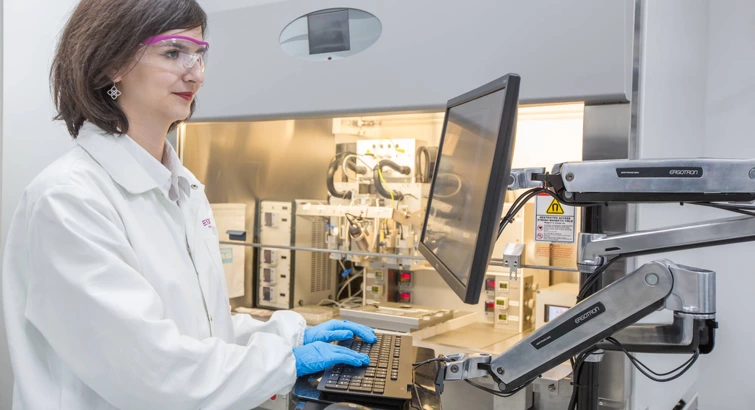
The head of Evonik’s Tissue Engineering project house in Singapore, Alexander König, uses a microscope to observe how human cells multiply in a nutrient solution.

Jennifer Bourland works with a 3D printer at the Tissue Engineering project house in Singapore.
Research & Development
A second skin from the laboratory: Evonik explores the future of tissue engineering
Pain, fluids, odor—and endless dressing changes: Chronic wounds often fail to close, and patients’ bodies appear unable to heal. The current therapies for such wounds are arduous and often do not bring lasting success. This is the starting point for the researchers from Evonik.
- The aim: Develop innovative products and processes for synthetic production of biological tissue
- Evonik is significantly expanding its competencies in the area of regenerative medicine
- Innovative solutions and applications for the pharmaceutical, dermatological and cosmetics sector
Essen/Singapore. Pain, fluids, odor—and endless dressing changes: Chronic wounds often fail to close, and patients’ bodies appear unable to heal. The current therapies for such wounds are arduous and often do not bring lasting success. This is the starting point for the researchers from Evonik. They are developing new materials and procedures to simplify and accelerate the growth of skin tissue in the laboratory and to increase reproducibility. The development of innovative therapeutic approaches for the treatment of chronic and burn wounds is only one of the goals of Evonik’s Tissue Engineering Project House.
Tissue engineering refers to the development of substitute materials that can restore, maintain or improve the function of biological tissue with the help of cultured cells. “Cells in the laboratory need a scaffold and a specific nutrient mix to organize and reproduce in the same way as in the human body,” explains chemist Alexander König, the head of the project house based in Singapore. “Overall, there are over 300 ingredients which must be combined in an optimal fashion.” The researchers are now tackling this challenge with the aim to develop innovative solutions.
“We are researching all components because we want to offer our customers the best material for tissue engineering,” says König. His team can rely on extensive expertise in the area of medical applications. Amino acids and derivatives, peptides and biodegradable polymers are already part of Evonik’s portfolio. König is certain that this will generate strong impulses in the
market for regenerative medical products.
As an example, cultured cells or skin tissue from the laboratory can be used for novel therapies in wound healing. “This would involve culturing and expanding a patient’s cells in vitro—in the
laboratory, that is,” König explains. The same cells are then reimplanted into the wound to initiate or accelerate the healing process. Further developments in skin grafts are another option.
Thus, it may become feasible to grow the patient’s own skin in the laboratory and then apply it to the wound. Today, in most cases, the patient’s own skin is used as the graft.

However, the demand for laboratory-engineered skin goes far beyond the area of clinical applications. There is also a need for optimized approaches for so-called skin models, realistic replicas of the human skin that are employed for research and testing purposes in laboratories, for example to test new cosmetic ingredients, cleaning agents or chemicals.
Currently available skin models do not adequately reflect natural skin. Challenges also persist for the standardized clinical use of artificial tissue after accidents or illnesses—clinical approval is
frequently denied. The reasons are diverse and are not only due to the complexity of the largest human organ. Production is expensive and labor-intensive, and some materials typically used
in tissue engineering are susceptible to quality fluctuations. That applies, for example, to substances of animal origin. “It is hardly possible to scale or transfer them to the application,” explains König. In addition, many work steps still have to be completed by hand. “These factors are major obstacles for approval by health authorities.”
The Evonik scientists are therefore not only researching innovative procedures, but are also working to optimize the involved materials. “Our approach involves chemically produced, synthetic materials that have the same biological compatibility as animal products, while offering the right mechanical and physical characteristics.” Benefits include better reproducibility and
consistent material quality. In addition, there is no risk of disease transmission, which can be one of the risks when using products of animal origin.
The researchers in the Tissue Engineering Project House in Singapore are working in close interdisciplinary collaboration with Evonik experts in the USA and Germany for a period of three
years. Their research activities are supplemented by projects and cooperation agreements with external institutions. “Our vision is to create efficient solutions based on our existing competencies, further research activities, and external expertise to enable our customers to develop optimized products,” says König. Based on the project house developments, Evonik aims to offer new scaffold materials and nutrient solutions for tissue engineering in commercial applications in the future.
Company information
Evonik is one of the world leaders in specialty chemicals. The focus on more specialty businesses, customer-oriented innovative prowess and a trustful and performance-oriented corporate culture form the heart of Evonik’s corporate strategy. They are the lever for profitable growth and a sustained increase in the value of the company. Evonik benefits specifically from its customer proximity and leading market positions. Evonik is active in over 100 countries around the world. In fiscal 2018, the enterprise with more than 32,000 employees generated sales of €13.3 billion and an operating profit (adjusted EBITDA) of €2.15 billion from continuing operations.
Disclaimer
In so far as forecasts or expectations are expressed in this press release or where our statements concern the future, these forecasts, expectations or statements may involve known or unknown risks and uncertainties. Actual results or developments may vary, depending on changes in the operating environment. Neither Evonik Industries AG nor its group companies assume an obligation to update the forecasts, expectations or statements contained in this release.
